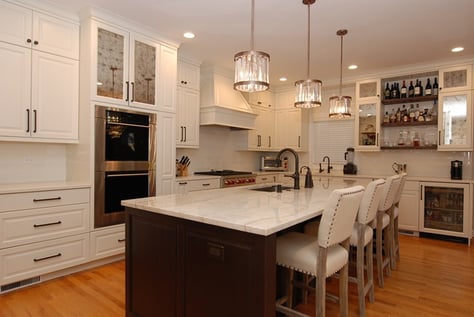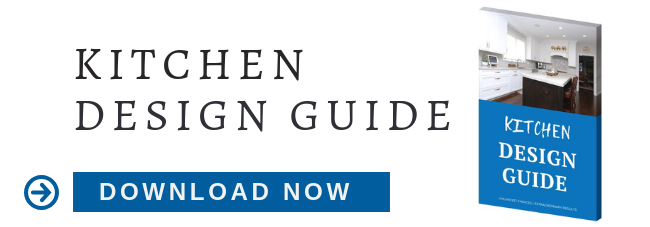 We often recommend that clients take their cabinets to the ceiling – soffit or not – for three reasons; first, it increases kitchen storage space and that’s always a bonus, especially in a small kitchen. Second, it eliminates any dead space above the upper-cabinet boxes, preventing the top of the cabinet box from becoming a dust and debris trap and, finally, it provides a nice, streamlined look.
We often recommend that clients take their cabinets to the ceiling – soffit or not – for three reasons; first, it increases kitchen storage space and that’s always a bonus, especially in a small kitchen. Second, it eliminates any dead space above the upper-cabinet boxes, preventing the top of the cabinet box from becoming a dust and debris trap and, finally, it provides a nice, streamlined look.
Rather than extending cabinet boxes up in a single unit, many Chicago kitchen designers choose to use stacked cabinets (also called double-stacked cabinets) instead. With this approach, there are two sets of cabinets, typically a larger set on the bottom layer and a smaller set on the top – with the top stack being about one-half the width of the cabinets below them. Crown moulding can be used at the top to take up any additional space or to clean up the juncture between cabinet and ceiling in cases where the proportional balance leaves a gap at the top.
The question becomes: Are stacked cabinets a good idea for your kitchen remodel?
The Pros and Cons of Stacked Kitchen Cabinets in a Chicago Kitchen Design
Only you can decide if stacked cabinets are a good move for your kitchen remodel, but here are some Pros & Cons to help you figure it out.
Pro: Extra storage space
Storage is one of the biggest benefits of stacked cabinetry. Unless you have a large kitchen, storage is probably at a premium. If you have a kitchen where there’s a foot or more of space above the cabinets, and you’re hungry for storage, it makes sense to either take your cabinets all the way to the ceiling or make them stacked.
Con: It’s an extra expense
Anytime you add extra anything it will cost you more, and that is certainly true for stacked cabinetry, which requires an additional layer of both cabinet boxes and doors. If this is a concern for your budget, you might be able to use semi-custom options here, depending on the design.
Pro: They break up the monotony
The wall-to-wall, and veritable ceiling to floor cabinet look, can be monotonous. Rather than having one, tall upper cabinet bank, with a single, door panel, stacked cabinets break the look up. The division between the two halves adds a proportional dimension to the kitchen, and you can use different cabinet door inserts – like glass – to add varied, visual interest.
That being said, you’ll want to be careful. Too many cabinets can be monotonous no matter how varied they are so your Chicago kitchen remodeler should help you strike just the right balance.
Con: More to clean and maintain
Of course, you’ll also have more door and interior cabinet spaces to clean and maintain, so that’s worth considering. Since they’re more difficult to access, wiping down and polishing the upper-most cabinet doors may require outside help depending on your physical ability and interest.
Pro: Spice up your lighting plan
The combination of stacked cabinets, glass door inserts and interior cabinet lighting are a win-win-win when it comes to illuminating your kitchen after hours. The glow from the upper-upper cabinets in the stack is beautiful and – when paired with dimmers – it can add just the right ambience (and a nighttime safety feature) to your Chicago kitchen design.
Con: They’re more difficult to access
Obviously, the upper-stacks of your double-stacked cabinets are not the place to store everyday dishes. Because they live up near the ceiling, these cabinets are more difficult – and dangerous – to access. We recommend saving them for those seasonal or barely-used items. Or, in the case of glass door inserts, preserving the majority of them for display purposes so you rarely have to access them at all.
When you work with Kitchens & Baths Unlimited, we’ll discuss all the pros and cons of stacked cabinets so you feel 100% confident with your final decision. Contact us to schedule your kitchen design consultation. 847-729-1212.



